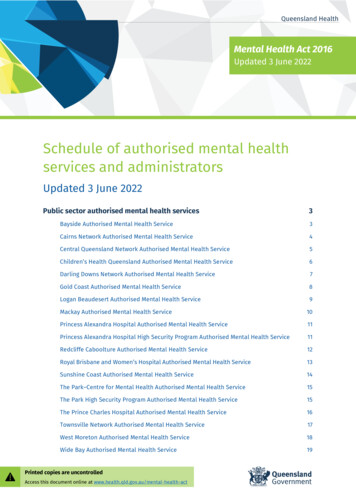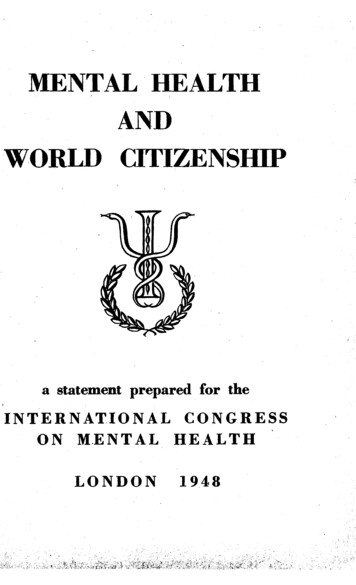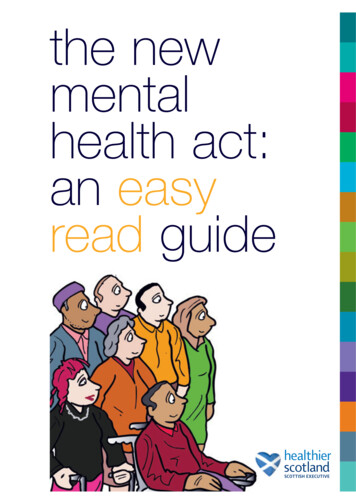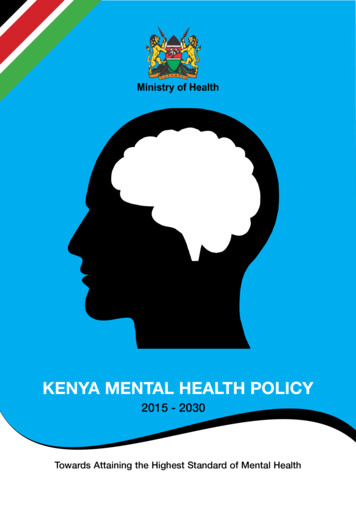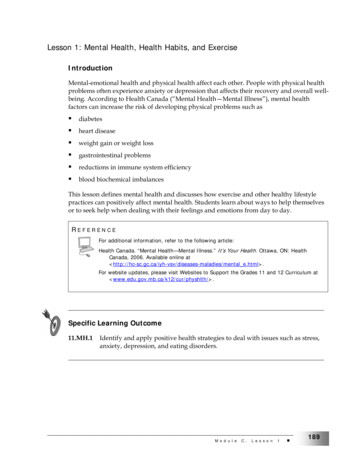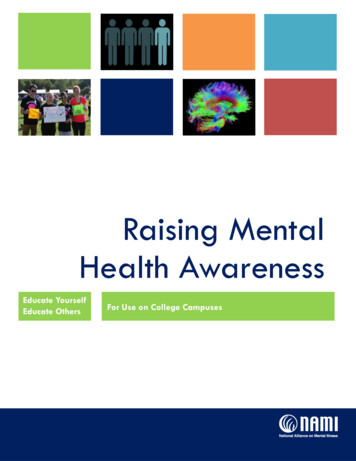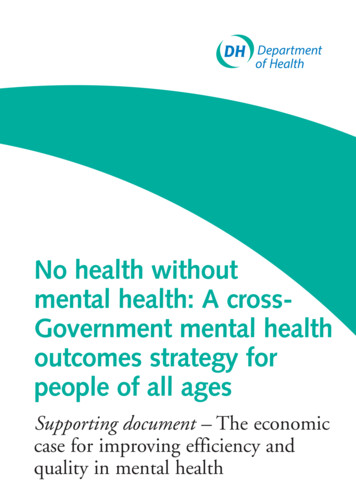
Transcription
No health withoutmental health: A crossGovernment mental healthoutcomes strategy forpeople of all agesSupporting document – The economiccase for improving efficiency andquality in mental health
No health without mental health:A cross-Government mental health outcomes strategy forpeople of all agesSupporting Document - The economic case for improvingefficiency and quality in mental healthContentsINTRODUCTIONAREAS FOR INTERVENTION1Early identification and intervention as soon as mental health problems emerge2The promotion of positive mental health and prevention of mental disorder inchildhood and adolescence3The promotion of positive mental health and prevention of mental disorder in adults4Addressing the social determinants and consequences of mental health problems5Improving the quality and efficiency of current servicesCONCLUSIONANNEX 1Costs of different mental disorders across the life course2
INTRODUCTION1.Mental ill health is the single largest cause of disability in the UK, contributing up to22.8% of the total burden, compared to 15.9% for cancer and 16.2% forcardiovascular disease1. The wider economic costs of mental illness in England havebeen estimated at 105.2 billion each year. This includes direct costs of services,lost productivity at work and reduced quality of life2.2.In 2008/9, the NHS spent 10.8% of its annual secondary healthcare budget on mentalhealth services, which amounted to 10.4 billion3. Service costs which include NHS,social and informal care costs amounted to 22.5 billion in 2007 in England4.3.Although the NHS as a whole was protected from cuts in the 2010 Spending Review,rising demand means that the NHS has to find up to 20 billion in efficiency savingsby 2014. As nearly 11% of England’s annual secondary care health budget isallocated to mental health care, the mental health sector cannot be exempt fromhaving to make savings. There are many interdependencies between physical andmental health, so any efficiencies in mental health services need to be carefullythought through so that false economies and greater costs elsewhere in thehealthcare and social care system are avoided. The Coalition Government has madeit clear that it expects parity of esteem between mental and physical health services.4.Estimates of the cost of different mental disorders across the life course in Englandhave been made and are detailed in Annex A. Estimated annual costs for differentconditions are: depression 7.5 billion, anxiety 8.9 billion4, schizophrenia 6.7billion5, and dementia 17 billion6. The estimated annual costs of medicallyunexplained symptoms1 are 18 billion.75.Good mental health and wellbeing, and not simply the absence of mental illness,have been shown to result in health, social and economic benefits for individuals,communities and populations 8 9 10 11. Such benefits include: better physical health;reductions in health-damaging behaviour;greater educational achievement;improved productivity;higher incomes;reduced absenteeism;less crime;more participation in community life;improved overall functioning; andreduced mortality.1Medically unexplained symptoms (MUS) are persistent physical complaints that do not yet have areadily recognisable medical cause. The pain, worry and other symptoms are, nevertheless, real andcause distress. The term somatisation disorder is also sometimes used.3
6.Therefore, improved wellbeing and resilience against adversity and mental ill healthimpact across a broad range of areas and have significant economic implications.7.Although future costs of mental ill health are forecast to double in real terms over thenext 20 years, some of this cost could be reduced by greater focus on wholepopulation mental health promotion and prevention, alongside early diagnosis andintervention.128.A wide range of effective evidence-based early interventions can be applied in healthand social care and beyond, across other sectors. These can build individual andpopulation resilience, prevent problems starting or developing further, and improveoutcomes.9.There is increasingly robust evidence that a range of innovative and preventativeapproaches can also reduce costs by improving outcomes and increasing quality andproductivity13. Such approaches are also supported in consensus statements from thevoluntary sector.1410.Areas for potential intervention include:1.2.3.4.5.early identification and intervention as soon as mental health problems emerge;the promotion of positive mental health and prevention of mental healthproblems in childhood and adolescence;the promotion of positive mental health and prevention of mental healthproblems in adults;addressing the social determinants and consequences of mental healthproblems; andimproving the quality and efficiency of current services.11.These approaches are not mutually exclusive. Local solutions, which reducespending, may include elements of all these approaches. Different types ofintervention can realise benefits over the short, medium and longer term and often inareas other than health. For instance, the majority of economic savings frominvestment in mental health promotion for children and families often accrue throughreductions in crime and improved earnings. By contrast, reducing the number ofpeople who miss their appointments may decrease immediate costs to the NHS.Research, evaluation and innovation are critically important so that we learn whatworks and what does not and can disseminate effective practice.12.Each type of approach is detailed in the following sections. Some of the evidencegiven is also reported within the Impact Assessment (IA), which accompanies Nohealth without mental health; a cross-Government outcomes strategy for people of allages.13.The Department of Health commissioned additional economic modelling from theLondon School of Economics (LSE) for a range of interventions with a good evidencebase, which will be shortly published as a further supporting document on the DHwebsite. These are listed at paragraph ten above (interventions 1-4). The quantity4
and quality of the evidence base for each intervention varies. The criteria for inclusionwere that the evidence base of effectiveness was sufficiently robust and includedeconomic evaluation, although not all were UK based. In carrying out the modelling,a number of assumptions were made. The results are, therefore, theoreticalestimates of potential savings and are still to be formally peer reviewed. However,they do give indications of promising areas for further local analysis, planning andcommissioning. Any comparisons across interventions should allow for the verydifferent assumptions made in the modelling work.5
1.81. Early identification and intervention as soon as mental health problemsemergeConduct disorder - parenting interventions for families1.1Conduct disorder is the most common mental disorder in childhood and adolescence.It leads to a range of difficulties and associated costs for children, families and societyacross the life course. Half of all children with conduct disorder develop anti-socialpersonality disorder as adults15, and conduct disorder is associated with a 70 foldincreased risk of being imprisoned by the age of 2516. The annual cost of crime inEngland and Wales committed by adults who had conduct disorder as children andadolescents has been estimated at 22.5 billion17. There is good evidence thatparenting interventions are effective18. The Analysis of the Impact on Equality (AIE)gives estimates of net savings to the Exchequer from providing parent-trainingprogrammes to cohorts of children with conduct disorders. Many of the benefits fromchildhood interventions extend into adult life. Total gross savings over 25 years havebeen estimated at 9,288 per child and thus exceed the average cost of theintervention by a factor of around eight to one19.Early intervention for psychosis1.2NHS Early Intervention teams target people in the general population aged 15 to 35years experiencing a first episode of psychosis. The IA gives estimates of savingsthat could be made if current early intervention services were extended to cover thetotal population in England. Over 10 years, net savings to the NHS would amount to 290 million increasing to around 550 million if wider economic savings were takeninto account.Early detection of psychosis1.3Early detection services identify early symptoms of psychosis. There is evidence thatearly treatment may reduce the number of people who go on to develop psychoticillness from 35% to 15%20 21. Analysis in the IA compares the impact of current carewith the effects of extending early detection services across England. Over 10 years,net savings of around 330 million to the NHS were estimated, and around 140million to the wider public sector, increasing to 1.7 billion if wider costs are taken intoaccount.Screening and brief intervention in primary care for alcohol misuse1.4The overall economic and social costs of alcohol misuse in England in 2006/07 wereestimated at 17.7 - 25.1 billion22. Brief nurse-delivered interventions in primary carehave been shown to be effective in reducing alcohol consumption23. They involvediscussion of and giving information about alcohol consumption and possibleapproaches. The IA gives estimated savings from screening and brief intervention foralcohol misuse in primary care. The potential annual net savings modelled arearound 40 million to the NHS and a further 40 million to the criminal justice system.There are also 220 million in productivity gains and 190 million in other benefits.6
Total gross savings are 204.55 per person over 7 years following the intervention24.Early diagnosis and treatment of depression at work1.5A number of previous studies in different workplaces have shown that early diagnosisand treatment at work can be effective in tackling depression and reducingproductivity losses25. Cognitive Behavioural Therapy (CBT) has been shown to beeffective in reducing the risk of depression in the workplace26. The IA describeseconomic modelling work undertaken by the LSE on the benefits of workforcescreening for depression of all employees. These benefits come from lowerabsenteeism and improved productivity.2. Promotion of positive mental health and prevention of mental disorder inchildhood and adolescence2.1As half of lifetime mental ill health is already present by the age of 14, preventiontargeted at younger people can result in greater personal, social and economicbenefits than intervention at any other time in the lifespan. The followinginterventions to improve mental health and prevent mental illness in children andyoung people were subject to economic modelling by the LSE.Health visitor interventions to reduce postnatal depression2.2Postnatal depression is associated with worse outcomes for the children of affectedmothers. Health visitor-delivered intervention for mothers with postnatal depressionhas been shown to be effective. The economic benefits resulting from a reduction inlifetime disadvantages to these children have been estimated as providing a netbenefit27. A further ongoing evaluation of potential national savings is beingundertaken, and will be published in due course.Prevention of conduct disorder through social and emotional learning programmes2.3Reviews of social and emotional learning programmes show improvement in socialemotional skills, attitude about self and others, social behaviour and academicperformance in children as well as reduced emotional distress and conductproblems28 29. Economic estimates suggest cost savings over two years are morethan twice the initial investment with cumulative net savings per child of 6,639 afterfive years and 10,032 after 10 years30.School-based violence prevention programmes2.4Economic modelling has been undertaken to estimate benefits for six-year-oldchildren receiving school-based violence prevention programmes. This shows theinterventions become cost effective and cost saving within three years. Net savingsare 829 per child at year six, increasing to 1,721 per child at year seven, 6,446 atyear 10 and 8,223 at year 1531. In the first six years, most savings accrue to thepublic sector, particularly the NHS and Education. After six years, there are greater7
savings because of reduced lost output due to crime as well as reduced victim costs.Actual total savings are higher, as estimates do not include crime-related costsincurred by children under the age of 10 or the educational and health impacts onother children in a class with a disruptive child.School-based interventions to reduce bullying2.5Averaged across all children, whether bullied or not, the economic savings of schoolbased bullying prevention programmes are 1,080 per school pupil32. Theintervention costs only 15.50 per pupil and results in improved psychologicalwellbeing. The measured benefits are long-term in nature and accrue mainly toindividuals in the form of higher incomes. However, there will also be associatedincreased tax revenues and savings in social security expenditure, since victimisationis associated with higher rates of worklessness as well as reduced earnings when inwork.2.6There is growing evidence of the cost effectiveness of a number of other interventionsincluding both the nurse home visiting programme33 as well as Family InterventionProjects 34 and Multi-dimensional treatment foster care35 36. However, economicmodelling was not commissioned in these intervention areas.3. Promotion of positive mental health and prevention of mental disorder inadulthoodTime banks and community navigators3.1Developing social capital through projects that build community capacity can benefitthe community at large, as well as individuals, recipients and providers involved insuch initiatives. 37 38 Time banks use hours of time rather than pounds as acommunity currency. Participants contribute their own skills, practical help orresources in return for services provided by fellow time bank members. Separateeconomic modelling by the LSE found that the cost of each time bank member wouldaverage less than 450 per year, but a conservative estimate of the economic valueof the contribution of each member would exceed 1,300. 393.2The IA also describes the economic benefits of community navigator services, whichhelp people to follow more effective pathways through local services. A separateeconomic analysis by the LSE estimated that supporting each person through acommunity navigator service would cost a little under 30040.In addition, the costs of visits to a Citizens’ Advice Bureau or Jobcentre Plus (around 180) should also be taken into account. The benefits of these schemes to individualsinclude fewer GP visits, increased employment and more rapid return to work. Thesebenefits have been estimated at about 900 per person per year, with even greaterbenefits if account is take of improved quality of life.8
Work-based mental health promotion3.3The promotion of mental wellbeing of employees can have economic benefits forbusiness from increased commitment and job satisfaction, staff retention, improvedproductivity and performance, and reduced staff absenteeism41. Multi-componenthealth promotion programmes2 have been shown to significantly reduce the risk ofstress, improve work performance and reduce absenteeism42. Economic modellingfound that initial investment of 40,000 in such a promotion programme in a largesized multinational company could potentially result in net savings of over 340,000over a 12-month period. This would equate to a nine fold annual return oninvestment from productivity gains and reduced absenteeism43. Potential additionalbenefits to the health system from reduced illness are not included. It is not clear towhat degree these findings can be generalised to other workplaces, but clearly this isan area worthy of further exploration.Suicide prevention3.4The cost of suicide is calculated by attributing economic costs to the distress sufferedby relatives of the person who has committed suicide. 44 This accounts for 70% of thetotal costs, and lost output accounts for 30% of the cost. Economic modelling workhas estimated that suicide-training courses provided to all GPs in England couldresult in net savings of over 500 million after one year and further considerablesavings over the longer term45.3.5Further economic modelling has shown significant annual savings following theinstallation of a safety barrier around a bridge suicide hot spot. Taking a one-yearcohort and estimating savings over 10 years gave savings of 2.6-3.0 million forthose who did not attempt suicide by another method. The savings would be 2.12.5 million for those who attempted suicide by another method.464. Addressing social determinants and consequences of mental health problems4.1Economic modelling has shown savings from interventions which aim to tackle socialdeterminants and consequences of mental ill health.Debt advice4.2Low income and debt are associated with higher rates of mental illness. Studiessuggest that the effect of low income on mental health may largely be explained bythe effect of debt47. Moreover, people with mental health problems are more likely toget into problematic debt. Rates of debt in people with no mental health problems are8%. The rates for those with depression and anxiety are 24%, and for those withpsychosis 33%. The IA gives estimates of the costs associated with face-to-face debt2These include personalised health information and advice, tailored health improvement web-portal,wellness literature, and seminars and workshops focusing on wellness issues.9
advice over 5 years as around 250 million. Associated savings are estimated ataround 30 million to the NHS, and around 50 million on legal costs with around 220 million from productivity gains. However, these figures exclude severalimportant benefits such as debt repayments to creditors and health and wellbeinggains to individuals48.Befriending for older people4.3Older people can experience social isolation and loneliness. This increases their riskof depression, other mental health problems and poor wellbeing49 50. The prevalenceof loneliness among older people has been estimated at between 5% and 16% in theUK51. Loneliness is also associated with cognitive decline in older adults52.Befriending interventions for older people are often organised by the voluntary sector,using volunteers. They aim to alleviate social isolation and loneliness and prevent orreduce depression in this group. The LSE work shows that preventing lonelinesscould reduce health service use by older people and lead to substantial savings. Thisis based on befriending interventions piloted under the Brighter Futures Groupprogramme53.Reducing stigma and discrimination4.4A systematic review found that stigma and discrimination related to mental illnesshave a range of financial impacts through effects on employment, income, publicviews about resource allocation and healthcare costs54. A decision model was usedto estimate the economic impact of an anti-stigma campaign. It assumed that acampaign would increase the number of people with depression accessing servicesand that they therefore would stay in or return to work. This extra benefit amounted to 421 per person55.4.5The IA considers the economic impact of the Time to Change programme andconcludes that:4.6 the economic benefits of such a campaign would outweigh the costs at leasteightfold if the programme resulted in only an additional 1% of people withdepression accessing services and gaining employment; and if as a result of the campaign, 10% more people with psychosis accessed earlyintervention services the savings could be around 5.5 million per year.There are other interventions in this area with good evidence of cost effectiveness,but for which similar economic modelling has not been undertaken. Examples are setout below.Targeted employment support for those recovering from mental health problems4.7A review of Individual Placement and Support programmes (IPS) for those recoveringfrom mental health problems found that the employment rate was 61% for peopleusing IPS compared with 23% for people using traditional services56. A multi-siteEuropean trial found lower rates of hospital use for IPS clients than for those in10
traditional services with savings of 6,000 per client due to reduced inpatient costsover an 18-month period57.Housing support services4.8The Department of Health’s Care Services Efficiency Delivery Unit undertook a seriesof audits of housing-based support service in mental health, which suggest thathousing-based support services for people with mental health problems could delivercost savings to health and social care of 10,000 – 20,000 per year per client58.One audit estimated that supported housing for men with enduring mental illnesscould save 11,000 - 20,000 each year per client59 . Another audit showed thatsupported housing for women with multiple, complex needs including mental healthproblems could save local authorities and the NHS 12,000 each year per client60.The estimates exclude costs from ambulance use and police and court costs. Afurther audit of supported housing for people with moderate mental health needs,after discharge from hospital, estimated savings of 22,000 for each client per yearacross the wider health and social care system61. The Case Services Efficiency Unitalso calculated savings resulting from homecare re-enablement such as one to onesupport62.Warm housing4.9 The risk of common mental health problems is almost double for people living in fuelpoverty63. The estimated annual cost of this to the NHS is 859 million in England. Thecost of insulation and heating interventions to ensure warm homes is 252 million.64Government grants exist for such interventions, which have been shown to halve therates of common mental health problems.65.5. Improving the quality and efficiency of current mental health services5.1The NHS as a whole needs to identify up to 20 billion of efficiency savings by 2014to deliver quality improvements and to meet demographic and other pressures. Anumber of projects are underway within mental health services, both locally andnationally in support of the Quality, Innovation, Productivity and Prevention (QIPP)initiative. These contribute towards improved productivity and reducing waste whileimproving service quality and better health outcomes.5.2The Department of Health has been working with the NHS, providers andcommissioners, the Audit Commission and other stakeholders to identify ways ofimproving quality and reducing costs.5.3Current initiatives include: improvements to the acute care pathway;managing ‘out of area’ placements in acute and secure services moreefficiently; and11
addressing unmet psychological needs in people with medically unexplainedsymptoms or long term conditions such as diabetes, respiratory illness or heartdisease.Improvements to the acute care pathway5.4There are examples of innovative practice along the whole of the acute care pathway.An Improvement Tool for providers has been developed within the NHSConfederation. It is based on available data, existing evidence and good practiceexamples. It supports local health and social care economies to scope potential forimproving quality, efficiency and effectiveness; develop focused action plans; andreview quality and cost improvements.5.5In its work with partner organisations on QIPP, the Department of Health analystshave estimated potential savings from improvements in the acute care pathway. Thiswork suggests potential national gross savings of around 224 million per annum by2014/15. This is based on a reduction in the number of bed days (as a proportion ofthe number of people with mental health problems) in those PCT areas with thehighest bed-day usage (i.e. above the upper quartile level) to the quartile level. Theanalysis does control for various socio-economic factors that explain variationbetween PCT areas.5.6Examples of approaches that may help to achieve this reduction include: Improving recognition of mental health problems in primary care to ensureeffective early treatment and referral to secondary services where appropriatecan reduce the need for inpatient care; Early intervention for people with ‘at risk mental states’ can also reduceinpatient stays and costs (see paragraph 1.2 above) 66; Comprehensive use of crisis resolution and home treatment services includingmedical staffing and medications management to avoid unnecessary hospitaladmissions 67; Reducing the numbers of inappropriate assessments referred to crisis resolutionand home treatment teams in order to provide more capacity for hometreatment; Alternatives to admission, for example voluntary sector-run crisis houses68,acute day care and investment in peer support workers, which may reduceadmissions; Appropriate diversion to and input from other services. It is also important tomake sure people get support from the most appropriate agency as speedily aspossible in the least restrictive environment. For example, timely assessmentand diversion to other services including assertive outreach services andvoluntary services as appropriate;12
The whole care pathway, especially the inpatient stay, must be effective toavoid unnecessarily long stays in hospital. Sharing best practice, processmapping and Lean Management (or other similar techniques) may help toachieve this69; Ensuring appropriate and balanced capacity across the various elements ofinpatient provision, e.g. acute wards, psychiatric intensive care units, low securebeds, and rehabilitation services; Reducing delayed discharge through integration of housing options and housingpathways, effective use of supported housing, better access to social housingand the means to act as guarantor or to pay the bond to access private rentedaccommodation. Working with partner organisations on QIPP, the Departmentof Health has estimated that local areas could potentially make net savings ofaround 70m per year from reducing delayed discharges.5.7These approaches may result in reductions in bed numbers, and in only the moredisturbed patients being admitted to or remaining in hospital. This can have animpact on inpatient environments and the quality of care and potentially the numberof untoward incidents. It has implications for investment in skills, education andtraining of staff.5.8Different approaches may be effective for particular groups and should be consideredwhen commissioning services. For example: Effective approaches and case management in the community for people withpersonality disorder to reduce frequency and length of inpatient admissions.NICE guidelines also highlight how treatment of conduct disorder can preventantisocial personality disorder (ASPD), since half of children with conductdisorder develop ASPD as adults 70; Ensuring effective treatment for individuals with co-morbidity of mental illnesswith alcohol or drug misuse to reduce lengths of stay, readmissions and levelsof disturbance on wards; and Ensuring the availability of appropriate specialist services to, for example,individuals with eating disorders, older people with physical health needs,homelessness and other special needs.Managing ‘out of area’ placements in acute and secure services more efficiently5.9There are several aspects to managing ‘out of area’ placements more efficiently.They include: reducing unplanned ‘out of area’ placements; andreducing ‘out of area placements’ in medium secure services.Reducing unplanned ‘out of area’ placements13
5.10Out of area services are placements for people with mental health or social careneeds who are using mental health services (often medium-term treatment/rehabilitation, specialist or long–term care services) outside their home area.Sometimes local services would have been a practical alternative if available at thetime of placement or at a later stage.5.11Being placed out of area can mean that individuals receive care far from theirfamilies, friends and familiar surroundings. Lengths of stay may be longer as there isless continuity of care and it can be harder to arrange discharge, so costs can behigher. A number of areas have undertaken work to improve local systems andprevent people having to leave their area to access services. Practical tools, includingan implementation kit and briefing materials, are being developed.5.12Specialist inpatient services for children and young people are in short supply insome areas so that that young people are admitted far away from families andfriends, sometimes in out of area placements and sometimes in the private sector.This can be disruptive to their family life, friendships, relationships and education.5.13An example is included on the NHS Evidence QIPP Collection site71. It sets out thebenefits of strengthening mental health commissioning in this area across the NHSand local authorities to ensure an approach that takes into account the whole system.A range of evidence of effective commissioning approaches and implementation arealso included giving details of improved individual and system outcomes as well asactual and projected savings.Reducing Out of Area placements in medium secure services5.14Medium secure services are low volume but high cost. Even a small 1% efficiencyimprovement/cost reduction in medium secure services could save as much as 5million nationally. Commissioners in many regions report an increased demand forservices, a demand higher than the rate at which patients are currently progressingthrough the system. To manage the potential for increasing costs we have tomanage the increasing demand.5.15The Department of Health is identifying national best practice, successes andinnovations at a local and regional level. Applying this locally will help commissionersdevelop different appr
net savings of around 330 million to the NHS were estimated, and around 140 million to the wider public sector, increasing to 1.7 billion if wider costs are taken into account. Screening and brief intervention in primary care for alcohol misuse 1.4 The overall economic and social costs of alcohol misuse in England in 2006/07 were

